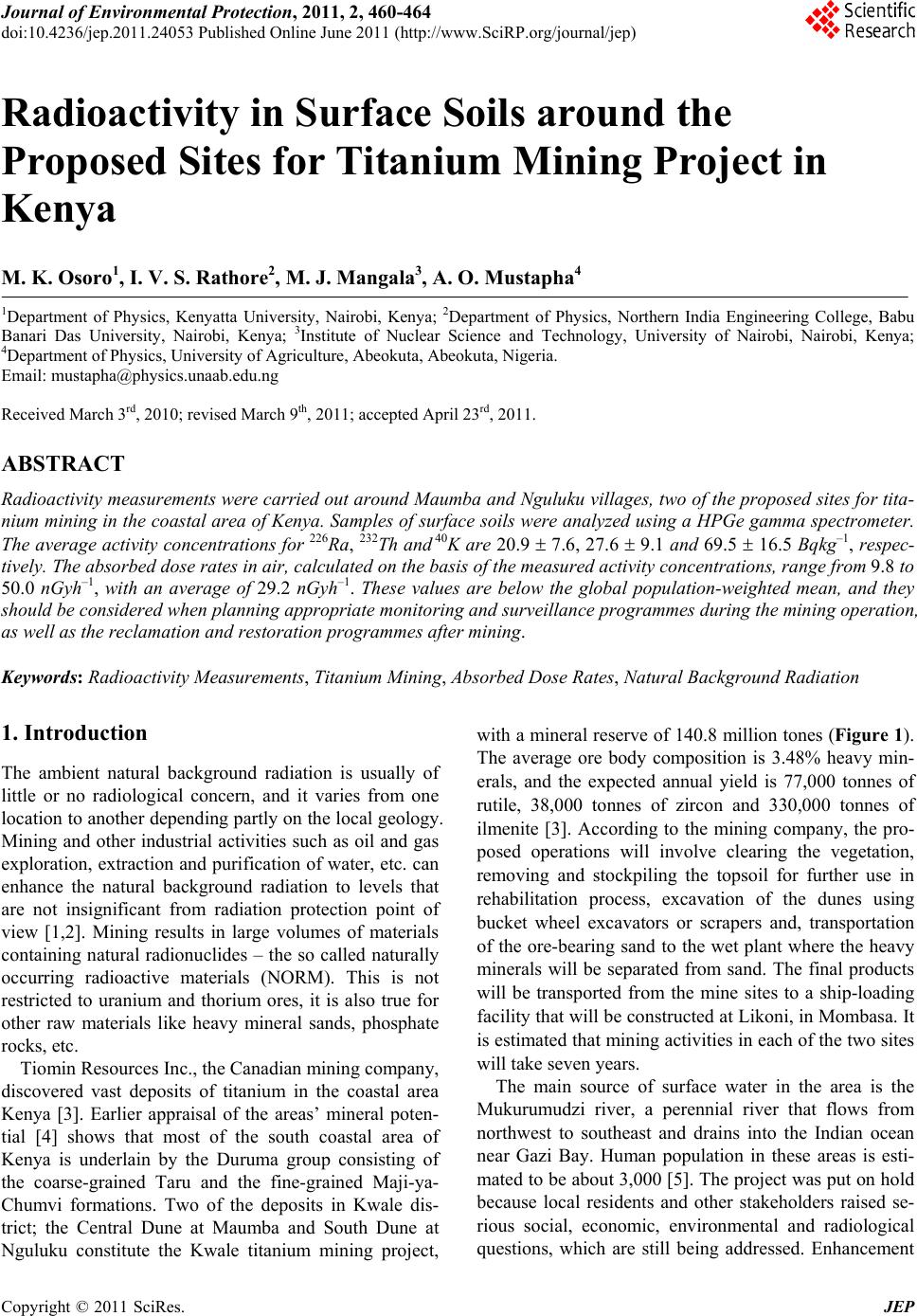
Journal of Environmental Protection, 2011, 2, 460-464
doi:10.4236/jep.2011.24053 Published Online June 2011 (http://www.SciRP.org/journal/jep)
Copyright © 2011 SciRes. JEP
Radioactivity in Surface Soils around the
Proposed Sites for Titanium Mining Project in
Kenya
M. K. Osoro1, I. V. S. Rathore2, M. J. Mangala3, A. O. Mustapha4
1Department of Physics, Kenyatta University, Nairobi, Kenya; 2Department of Physics, Northern India Engineering College, Babu
Banari Das University, Nairobi, Kenya; 3Institute of Nuclear Science and Technology, University of Nairobi, Nairobi, Kenya;
4Department of Physics, University of Agriculture, Abeokuta, Abeokuta, Nigeria.
Email: mustapha@physics.unaab.edu.ng
Received March 3rd, 2010; revised March 9th, 2011; accepted April 23rd, 2011.
ABSTRACT
Radioactivity measurements were carried ou t around Maumba and Nguluku villages, two of the proposed sites for tita-
nium mining in the coastal area of Kenya. Samples of surface soils were analyzed using a HPGe gamma spectrometer.
The average activity co ncentrations for 226Ra, 232Th and 40K are 20.9 7.6, 27.6 9.1 and 69.5 16.5 Bqkg–1, respec-
tively. The absorbed dose rates in air, calculated on the basis of the measured activity concentrations, range from 9.8 to
50.0 nGyh–1, with an average of 29.2 nGyh–1. These values are below the global population-weighted mean, and they
should be considered when p lanning app ropriate mon ito ring and su rveillance programmes du ring the mining op era tion,
as well as the reclamation and restoration programmes after mining.
Keywords: Radioactivity Measurements, Titanium Mining, Absorbed Dose Rates, Natural Background Radiation
1. Introduction
The ambient natural background radiation is usually of
little or no radiological concern, and it varies from one
location to another depending partly on the local geology.
Mining and other industrial activities such as oil and gas
exploration, extraction and purification of water, etc. can
enhance the natural background radiation to levels that
are not insignificant from radiation protection point of
view [1,2]. Mining results in large volumes of materials
containing natural radionuclides – the so called naturally
occurring radioactive materials (NORM). This is not
restricted to uranium and thorium ores, it is also true for
other raw materials like heavy mineral sands, phosphate
rocks, etc.
Tiomin Resources Inc., the Canadian mining company,
discovered vast deposits of titanium in the coastal area
Kenya [3]. Earlier appraisal of the areas’ mineral poten-
tial [4] shows that most of the south coastal area of
Kenya is underlain by the Duruma group consisting of
the coarse-grained Taru and the fine-grained Maji-ya-
Chumvi formations. Two of the deposits in Kwale dis-
trict; the Central Dune at Maumba and South Dune at
Nguluku constitute the Kwale titanium mining project,
with a mineral reserve of 140.8 million tones (Figure 1).
The average ore body composition is 3.48% heavy min-
erals, and the expected annual yield is 77,000 tonnes of
rutile, 38,000 tonnes of zircon and 330,000 tonnes of
ilmenite [3]. According to the mining company, the pro-
posed operations will involve clearing the vegetation,
removing and stockpiling the topsoil for further use in
rehabilitation process, excavation of the dunes using
bucket wheel excavators or scrapers and, transportation
of the ore-bearing sand to the wet plant where the heavy
minerals will be separated from sand. The final products
will be transported from the mine sites to a ship-loading
facility that will be constructed at Likoni, in Mombasa. It
is estimated that mining activities in each of the two sites
will take seven years.
The main source of surface water in the area is the
Mukurumudzi river, a perennial river that flows from
northwest to southeast and drains into the Indian ocean
near Gazi Bay. Human population in these areas is esti-
mated to be about 3,000 [5]. The project was put on hold
because local residents and other stakeholders raised se-
rious social, economic, environmental and radiological
questions, which are still being addressed. Enhancement